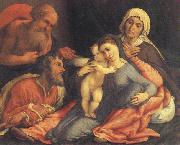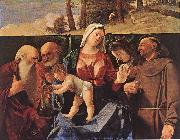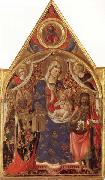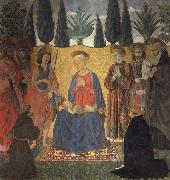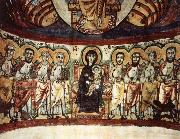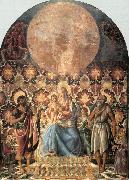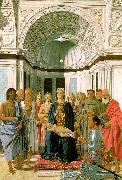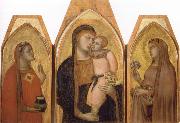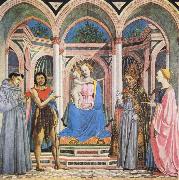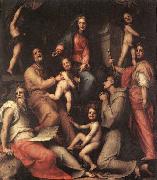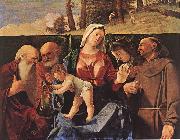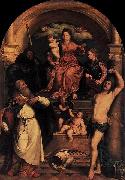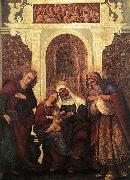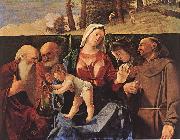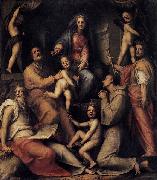Wholesale Oil Painting Reproductions No Minimum and Door to Door! |
|||||||||||
|
|
|||||||||||

|
|||||||||||
|
|
|
||||||||
All Lorenzo Lotto Oil Paintings |
||||||||
|
|
||||||||
|
|
||||||||
|
Artist Introduction: Italian
1480-1556
Lorenzo Lotto Galleries
In this last period of his life, Lorenzo Lotto would frequently move from town to town, searching for patrons and commissions. In 1532 he went to Treviso. Next he spent about seven years in the Marches (Ancona, Macerata en Jesi), returning to Venice in 1540. He moved again to Treviso in 1542 and back to Venice in 1545. Finally he went back to Ancona in 1549.
This was a productive period in his life, during which he painted several altarpieces and portraits :
Santa Lucia before the Judge, 1532, Jesi, Pinacoteca comunale
The Sleeping Child Jesus with the Madonna, St. Joseph and St. Catherine of Alexandria, 1533, Bergamo, Accademia Carrara
Portrait of a Lady as Lucretia, 1533, National Gallery, London.
Holy Family with SS Jerome, Anna and Joachim, 1534, Firenze, Uffizi
Holy Family, ca 1537, Paris, Louvre
Portrait of a Young Man, Firenze, Uffizi
Crucifixion, Monte San Giusto, Church of S Maria in Telusiano
Rosary Madonna, 1539, Cingoli, Church of San Nicolo
Portrait of a Man, 1541, Ottawa, National Gallery of Canada
Bust of a Bearded Man, 1541, ascribed, San Francisco, Fine Arts Museum
The Alms of Saint Anthony, 1542, Venezia, church SS Giovanni e Paolo
Madonna and four Saints, 1546, Venezia, Church of San Giacomo dell??Orio
Portrait of fra?? Gregorio Belo da Vicenza, 1548,New York, Metropolitan Museum
Assumption, 1550, Ancona, church San Francesco alle Scale
The Crossbowman, 1551, Rome, Pinacoteca Capitolina
Portrait of an Old man, ascribed, ca 1552, Saint Petersburg, Ermitage
Presentation in the Temple, 1555, Loreto, Palazzo Apostolico
A Venetian woman in the guise of Lucretia (1533).At the end of his life it was becoming increasingly difficult for him to earn a living. Furthermore, in 1550 one of his works had an unsuccessful auction in Ancona. As recorded in his personal account book, this deeply disillusioned him. As he had always been a deeply religious man, he entered in 1552 the Holy Sanctuary at Loreto, becoming a lay brother. During that time he decorated the basilica of S Maria and painted a Presentation in the Temple for the Palazzo Apostolico in Loreto. He died in 1556 and was buried, at his request, in a Dominican habit.
Giorgio Vasari included Lotto's biography in the third volume of his book Vite. Lorenzo Lotto himself left many letters and a detailed notebook (Libro di spese diverse, 1538-1556), giving a certain insight in his life and work. Among the many painters he influenced are likely Giovanni Busi |
||||||||
|
|
||||||||
|
Madonna and Child with Saints Painting ID:: 2597 |
1534
Galleria degli Uffizi, Florence |
|||||||
Height Width |
INS/CM Quality |
|||||||
|
X |
| |||||||
|
|
||||||||
All LOTTO, Lorenzo Oil Paintings |
||||||||
|
|
||||||||
|
|
||||||||
|
Artist Introduction: Italian High Renaissance Painter, ca.1480-1556
Italian painter and draughtsman. He had a long and often prosperous career as a painter, and, although he travelled widely, his style retained a close affinity with the paintings of his native Venice. He was one of an outstanding generation of painters, including Giorgione, Titian, Palma Vecchio and Pordenone, who appeared in Venice and the Veneto during the first decade of the 16th century. In comparison with his contemporaries, Lotto was a fairly traditional painter in that he worked primarily in the long-established genres of altarpieces, devotional pictures and portraiture. Such paintings were popular in the Venetian provinces and the Marches where Lotto spent much of his career and where he often received more money for his commissions than he could obtain in Venice. His most important commissions were for altarpieces, and he is perhaps best known for a series of sacre conversazioni in which he skilfully varied the symmetrical groupings of figures found in earlier Venetian treatments of the subject by Giovanni Bellini and Alvise Vivarini. Precedents in Venice were also important for Lotto's early efforts in bust-length portraiture, but from 1525 he made a considerable contribution to the development of the three-quarter-length portrait. He painted many private devotional paintings but only a few of the historical, mythological or allegorical scenes that were popular in northern Italy in this period. Lotto is one of the best-documented painters of the 16th century: 40 autograph letters dating from 1524 to 1539, |
||||||||
|
|
||||||||
|
|
Madonna and Child with Saints Painting ID:: 8008 |
c. 1506
Oil on wood, 83 x 105 cm
National Gallery of Scotland, Edinburgh |
||||||
Height Width |
INS/CM Quality |
|||||||
|
X |
| |||||||
|
|
||||||||
All Antonio Fiorentino Oil Paintings |
||||||||
|
|
||||||||
|
|
||||||||
|
Artist Introduction: Italian, 14th Century |
||||||||
|
|
||||||||
|
|
Madonna and Child with Saints Painting ID:: 29142 |
mk65
Tempera on panel
59x1/2x33"
|
||||||
Height Width |
INS/CM Quality |
|||||||
|
X |
| |||||||
|
|
||||||||
All Alessio Baldovinetti Oil Paintings |
||||||||
|
|
||||||||
|
|
||||||||
|
Artist Introduction: Florence ca 1425-1499 |
||||||||
|
|
||||||||
|
|
Madonna and Child with Saints Painting ID:: 29746 |
mk67
Tempera on panel
69 5/16x65 3/8in
|
||||||
Height Width |
INS/CM Quality |
|||||||
|
X |
| |||||||
|
|
||||||||
All unknow artist Oil Paintings |
||||||||
|
|
||||||||
|
|
||||||||
|
Artist Introduction: |
||||||||
|
|
||||||||
|
|
Madonna and Child with Saints Painting ID:: 30362 |
mk68
Freso
Cairo
Coptic Museum
c.500-600
|
||||||
Height Width |
INS/CM Quality |
|||||||
|
X |
| |||||||
|
|
||||||||
All Andrea del Castagno Oil Paintings |
||||||||
|
|
||||||||
|
|
||||||||
|
Artist Introduction: Italian
c1421-1457
Andrea del Castagno Location
Italian
c1421-1457
Andrea del Castagno Location
Italian painter. He was the most influential 15th-century Florentine master, after Masaccio, of the realistic rendering of the figure and the representation of the human body as a three-dimensional solid by means of contours. By translating into the terms of painting the statues of the Florentine sculptors Nanni di Banco and Donatello, Castagno set Florentine painting on a course dominated by line (the Florentine tradition of disegno), the effect of relief and the sculptural depiction of the figure that became its distinctive trait throughout the Italian Renaissance, a trend that culminated in the art of Michelangelo. |
||||||||
|
|
||||||||
|
|
Madonna and Child with Saints Painting ID:: 32207 |
c. 1445
Fresco, 290 x 212 cm |
||||||
Height Width |
INS/CM Quality |
|||||||
|
X |
| |||||||
|
|
||||||||
All Piero della Francesca Oil Paintings |
||||||||
|
|
||||||||
|
|
||||||||
|
Artist Introduction: Italian Early Renaissance Painter, ca.1422-1492 Italian painter and theorist. His work is the embodiment of rational, calm, monumental painting in the Italian Early Renaissance, an age in which art and science were indissolubly linked through the writings of Leon Battista Alberti. Born two generations before Leonardo da Vinci, Piero was similarly interested in the scientific application of the recently discovered rules of perspective to narrative or devotional painting, especially in fresco, of which he was an imaginative master; and although he was less universally creative than Leonardo and worked in an earlier idiom, he was equally keen to experiment with painting technique. Piero was as adept at resolving problems in Euclid, whose modern rediscovery is largely due to him, as he was at creating serene, memorable figures, whose gestures are as telling and spare as those in the frescoes of Giotto or Masaccio. His tactile, gravely convincing figures are also indebted to the sculpture of Donatello, an equally attentive observer of Classical antiquity. In his best works, such as the frescoes in the Bacci Chapel in S Francesco, Arezzo, there is an ideal balance between his serene, classical compositions and the figures that inhabit them, the whole depicted in a distinctive and economical language. In his autograph works Piero was a perfectionist, creating precise, logical and light-filled images (although analysis of their perspective schemes shows that these were always subordinated to narrative effect). However, he often delegated important passages of works (e.g. the Arezzo frescoes) to an ordinary, even incompetent, assistant. |
||||||||
|
|
||||||||
|
|
Madonna and Child with Saints Painting ID:: 32469 |
1472-74
Oil on panel, 248 x 170 cm
|
||||||
Height Width |
INS/CM Quality |
|||||||
|
X |
| |||||||
|
|
||||||||
All Ambrogio Lorenzetti Oil Paintings |
||||||||
|
|
||||||||
|
|
||||||||
|
Artist Introduction: Italian Byzantine Style Painter, ca.1290-1348
Ambrogio Lorenzetti (or Ambruogio Laurati; c. 1290 ?C June 9, 1348) was an Italian painter of the Sienese school. He was active between approximately from 1317 to 1348. His elder brother was the painter Pietro Lorenzetti.
His work shows the influence of Simone Martini, although more naturalistic. The earliest dated work of the Sienese painter is a Madonna and Child (1319, Museo Diocesano, San Casciano). His presence was documented in Florentine up until 1321. He would return there after spending a number of years in Siena.
The frescoes on the walls of the Hall of the Nine (Sala dei Nove) or Hall of the Peace (Sala della Pace) in the Palazzo Pubblico of Siena are one of the masterworks of early renaissance secular painting. The "nine" was the oligarchal assembly of guild and monetary interests that governed the republic. Three walls are painted with frescoes consisting of a large assembly of allegorical figures of virtues in the Allegory of Good Government . In the other two facing panels, Ambrogio weaves panoramic visions of Effects of Good Government on Town and Country, and Allegory of Bad Government and its Effects on Town and Country (also called "Ill-governed Town and Country"). The better preserved "well-governed town and country" is an unrivaled pictorial encyclopedia of incidents in a peaceful medieval "borgo" and countryside.
The first evidence of the existence of the hourglass can be found in one of his paintings.
Like his brother, he is believed to have died of bubonic plague 1348. Giorgio Vasari includes a biography of Lorenzetti in his Lives. |
||||||||
|
|
||||||||
|
|
Madonna and Child with Saints Painting ID:: 33277 |
mk83
1319-1348
Tempera on wood
87x41cm
|
||||||
Height Width |
INS/CM Quality |
|||||||
|
X |
| |||||||
|
|
||||||||
All DOMENICO VENEZIANO Oil Paintings |
||||||||
|
|
||||||||
|
|
||||||||
|
Artist Introduction: Italian Early Renaissance Painter, ca.1400-1461
|
||||||||
|
|
||||||||
|
|
Madonna and Child with Saints Painting ID:: 33380 |
mk86
c.1442-1448
Oil on wood
209x213cm
Florence,
Galleria degli Uffizi |
||||||
Height Width |
INS/CM Quality |
|||||||
|
X |
| |||||||
|
|
||||||||
All Jacopo Pontormo Oil Paintings |
||||||||
|
|
||||||||
|
|
||||||||
|
Artist Introduction: Italian 1494-1557 Jacopo Pontormo Galleries
Italian painter and draughtsman. He was the leading painter in mid-16th-century Florence and one of the most original and extraordinary of Mannerist artists. His eccentric personality, solitary and slow working habits and capricious attitude towards his patrons are described by Vasari; his own diary, which covers the years 1554-6, further reveals a character with neurotic and secretive aspects. Pontormo enjoyed the protection of the Medici family throughout his career but, unlike Agnolo Bronzino and Giorgio Vasari, did not become court painter. His subjective portrait style did not lend itself to the state portrait. He produced few mythological works and after 1540 devoted himself almost exclusively to religious subjects. His drawings, mainly figure studies in red and black chalk, are among the highest expressions of the great Florentine tradition of draughtsmanship; close to 400 survive, forming arguably the most important body of drawings by a Mannerist painter. His highly personal style was much influenced by Michelangelo, though he also drew on northern art, primarily the prints of Albrecht Derer. |
||||||||
|
|
||||||||
|
|
Madonna and Child with Saints Painting ID:: 50994 |
1518 Oil on wood, 214 x 185 cm San Michele Visdomini, Florence Pontormo executed this celebrated painting for the chapel of Francesco di Giovanni Pucci in the church San Michele Visdomini in Florence. |
||||||
Height Width |
INS/CM Quality |
|||||||
|
X |
| |||||||
|
|
||||||||
All Lorenzo Lotto Oil Paintings |
||||||||
|
|
||||||||
|
|
||||||||
|
Artist Introduction: Italian
1480-1556
Lorenzo Lotto Galleries
In this last period of his life, Lorenzo Lotto would frequently move from town to town, searching for patrons and commissions. In 1532 he went to Treviso. Next he spent about seven years in the Marches (Ancona, Macerata en Jesi), returning to Venice in 1540. He moved again to Treviso in 1542 and back to Venice in 1545. Finally he went back to Ancona in 1549.
This was a productive period in his life, during which he painted several altarpieces and portraits :
Santa Lucia before the Judge, 1532, Jesi, Pinacoteca comunale
The Sleeping Child Jesus with the Madonna, St. Joseph and St. Catherine of Alexandria, 1533, Bergamo, Accademia Carrara
Portrait of a Lady as Lucretia, 1533, National Gallery, London.
Holy Family with SS Jerome, Anna and Joachim, 1534, Firenze, Uffizi
Holy Family, ca 1537, Paris, Louvre
Portrait of a Young Man, Firenze, Uffizi
Crucifixion, Monte San Giusto, Church of S Maria in Telusiano
Rosary Madonna, 1539, Cingoli, Church of San Nicolo
Portrait of a Man, 1541, Ottawa, National Gallery of Canada
Bust of a Bearded Man, 1541, ascribed, San Francisco, Fine Arts Museum
The Alms of Saint Anthony, 1542, Venezia, church SS Giovanni e Paolo
Madonna and four Saints, 1546, Venezia, Church of San Giacomo dell??Orio
Portrait of fra?? Gregorio Belo da Vicenza, 1548,New York, Metropolitan Museum
Assumption, 1550, Ancona, church San Francesco alle Scale
The Crossbowman, 1551, Rome, Pinacoteca Capitolina
Portrait of an Old man, ascribed, ca 1552, Saint Petersburg, Ermitage
Presentation in the Temple, 1555, Loreto, Palazzo Apostolico
A Venetian woman in the guise of Lucretia (1533).At the end of his life it was becoming increasingly difficult for him to earn a living. Furthermore, in 1550 one of his works had an unsuccessful auction in Ancona. As recorded in his personal account book, this deeply disillusioned him. As he had always been a deeply religious man, he entered in 1552 the Holy Sanctuary at Loreto, becoming a lay brother. During that time he decorated the basilica of S Maria and painted a Presentation in the Temple for the Palazzo Apostolico in Loreto. He died in 1556 and was buried, at his request, in a Dominican habit.
Giorgio Vasari included Lotto's biography in the third volume of his book Vite. Lorenzo Lotto himself left many letters and a detailed notebook (Libro di spese diverse, 1538-1556), giving a certain insight in his life and work. Among the many painters he influenced are likely Giovanni Busi |
||||||||
|
|
||||||||
|
|
Madonna and Child with Saints Painting ID:: 83591 |
Date ca. 1506(1506)
Medium Oil on wood
Dimensions Height: 83 cm (32.7 in). Width: 105 cm (41.3 in).
cjr |
||||||
Height Width |
INS/CM Quality |
|||||||
|
X |
| |||||||
|
|
||||||||
All Paris Bordone Oil Paintings |
||||||||
|
|
||||||||
|
|
||||||||
|
Artist Introduction: Italian
1500-1571
Italian painter and draughtsman. He is best known for his strikingly beautiful depictions of women, both in portraits and in cabinet paintings. He also excelled in rendering monumental architectural settings for narrative, both religious and secular, possibly initiating a genre that would find great currency during the mid-16th century, especially in Venice, France and the Netherlands. His favoured media were oil and fresco, the latter being used on both interiors and faades. Although he was not generally sought after by Venetian patrons during his career, as his art was eclipsed by that of Titian, Paolo Veronese and Jacopo Tintoretto, Bordone was regarded in the mid-16th century as an accomplished artist (Pino; Sansovino). He worked for the moneyed lite of northern Italy and Bavaria, for the royalty of France and Poland, and had works commissioned to be sent to Spain and to Flanders. Despite knowledge of the important patrons for whom he worked, the chronology of Bordones oeuvre is by no means clear. Dating on stylistic grounds is confounded by the diverse sources on which he drew, ranging from the Emilian, Lombard and Venetian to the French and northern European, depending on the patron. Due to the ease with which prints circulated during Bordones career, it is difficult to ascertain whether influences were derived at first hand or from printed images. Such difficulties in assigning dates are further exacerbated by his use of the same figure study for numerous paintings evidently executed decades apart. Reliance on the testimony of Vasari, who interviewed Bordone in 1566, in conjunction with the extant documents, the few signed and dated paintings and, to a lesser extent, period fashion provides only a rough outline of his activity. Due to the lack of agreement among scholars regarding chronology, the following account is based mainly on the documentary evidence. |
||||||||
|
|
||||||||
|
|
Madonna and Child with Saints Painting ID:: 87007 |
1535(1535)
Medium Oil on poplar
cyf |
||||||
Height Width |
INS/CM Quality |
|||||||
|
X |
| |||||||
|
|
||||||||
All Lodovico Mazzolino Oil Paintings |
||||||||
|
|
||||||||
|
|
||||||||
|
Artist Introduction: Italian High Renaissance Painter, 1480-1528 |
||||||||
|
|
||||||||
|
|
Madonna and Child with Saints Painting ID:: 87413 |
between 1522(1522) and 1523(1523)
Medium Oil on wood
cyf |
||||||
Height Width |
INS/CM Quality |
|||||||
|
X |
| |||||||
|
|
||||||||
All Lorenzo Lotto Oil Paintings |
||||||||
|
|
||||||||
|
|
||||||||
|
Artist Introduction: Italian
1480-1556
Lorenzo Lotto Galleries
In this last period of his life, Lorenzo Lotto would frequently move from town to town, searching for patrons and commissions. In 1532 he went to Treviso. Next he spent about seven years in the Marches (Ancona, Macerata en Jesi), returning to Venice in 1540. He moved again to Treviso in 1542 and back to Venice in 1545. Finally he went back to Ancona in 1549.
This was a productive period in his life, during which he painted several altarpieces and portraits :
Santa Lucia before the Judge, 1532, Jesi, Pinacoteca comunale
The Sleeping Child Jesus with the Madonna, St. Joseph and St. Catherine of Alexandria, 1533, Bergamo, Accademia Carrara
Portrait of a Lady as Lucretia, 1533, National Gallery, London.
Holy Family with SS Jerome, Anna and Joachim, 1534, Firenze, Uffizi
Holy Family, ca 1537, Paris, Louvre
Portrait of a Young Man, Firenze, Uffizi
Crucifixion, Monte San Giusto, Church of S Maria in Telusiano
Rosary Madonna, 1539, Cingoli, Church of San Nicolo
Portrait of a Man, 1541, Ottawa, National Gallery of Canada
Bust of a Bearded Man, 1541, ascribed, San Francisco, Fine Arts Museum
The Alms of Saint Anthony, 1542, Venezia, church SS Giovanni e Paolo
Madonna and four Saints, 1546, Venezia, Church of San Giacomo dell??Orio
Portrait of fra?? Gregorio Belo da Vicenza, 1548,New York, Metropolitan Museum
Assumption, 1550, Ancona, church San Francesco alle Scale
The Crossbowman, 1551, Rome, Pinacoteca Capitolina
Portrait of an Old man, ascribed, ca 1552, Saint Petersburg, Ermitage
Presentation in the Temple, 1555, Loreto, Palazzo Apostolico
A Venetian woman in the guise of Lucretia (1533).At the end of his life it was becoming increasingly difficult for him to earn a living. Furthermore, in 1550 one of his works had an unsuccessful auction in Ancona. As recorded in his personal account book, this deeply disillusioned him. As he had always been a deeply religious man, he entered in 1552 the Holy Sanctuary at Loreto, becoming a lay brother. During that time he decorated the basilica of S Maria and painted a Presentation in the Temple for the Palazzo Apostolico in Loreto. He died in 1556 and was buried, at his request, in a Dominican habit.
Giorgio Vasari included Lotto's biography in the third volume of his book Vite. Lorenzo Lotto himself left many letters and a detailed notebook (Libro di spese diverse, 1538-1556), giving a certain insight in his life and work. Among the many painters he influenced are likely Giovanni Busi |
||||||||
|
|
||||||||
|
|
Madonna and Child with Saints Painting ID:: 87419 |
1506(1506)
Medium Oil on wood
cyf |
||||||
Height Width |
INS/CM Quality |
|||||||
|
X |
| |||||||
|
|
||||||||
All Jacopo Pontormo Oil Paintings |
||||||||
|
|
||||||||
|
|
||||||||
|
Artist Introduction: Italian 1494-1557 Jacopo Pontormo Galleries
Italian painter and draughtsman. He was the leading painter in mid-16th-century Florence and one of the most original and extraordinary of Mannerist artists. His eccentric personality, solitary and slow working habits and capricious attitude towards his patrons are described by Vasari; his own diary, which covers the years 1554-6, further reveals a character with neurotic and secretive aspects. Pontormo enjoyed the protection of the Medici family throughout his career but, unlike Agnolo Bronzino and Giorgio Vasari, did not become court painter. His subjective portrait style did not lend itself to the state portrait. He produced few mythological works and after 1540 devoted himself almost exclusively to religious subjects. His drawings, mainly figure studies in red and black chalk, are among the highest expressions of the great Florentine tradition of draughtsmanship; close to 400 survive, forming arguably the most important body of drawings by a Mannerist painter. His highly personal style was much influenced by Michelangelo, though he also drew on northern art, primarily the prints of Albrecht Derer. |
||||||||
|
|
||||||||
|
|
Madonna and Child with Saints Painting ID:: 89680 |
1518(1518)
Medium oil on panel
cyf |
||||||
Height Width |
INS/CM Quality |
|||||||
|
X |
| |||||||
|
|
||||||||
|
Prev Next
|
||||||||
|
|
||||||||
|
Related Paintings to Jacopo Pontormo :. |
||||||||
|
|
||||||||
|
CONTACT US |
